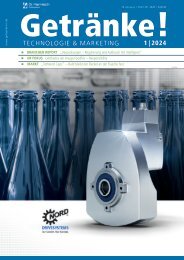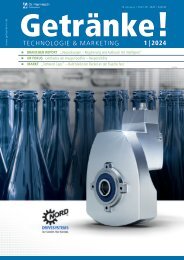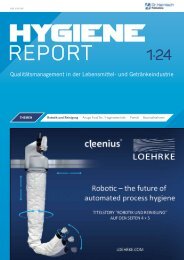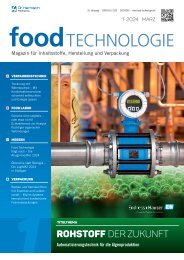Wellness Foods + Supplements 1/2022
Wellness Foods & Supplements is the first European magazine devoted exclusively to health ingredients, nutraceutical foods and beverages. Questions about the trade magazine Wellness Foods & Supplements? Interested in subscribing or advertising? The board of editors at Wellness Foods & Supplements kindly remains at your disposal.
Wellness Foods & Supplements is the first European magazine devoted exclusively to health ingredients, nutraceutical foods and beverages.
Questions about the trade magazine Wellness Foods & Supplements? Interested in subscribing or advertising? The board of editors at Wellness Foods & Supplements kindly remains at your disposal.
Create successful ePaper yourself
Turn your PDF publications into a flip-book with our unique Google optimized e-Paper software.
AMD and micronutrients<br />
centre of the retina. The macula lutea (Latin<br />
for “yellow spot”) located here is a place with<br />
a particularly high density of photoreceptor<br />
cells (Fig. 1). The macula owes its yellow<br />
colour to the antioxidant and UV light filtering<br />
pigments lutein and zeaxanthin, which are<br />
contained in 1.000-fold higher concentrations<br />
in this area, compared to blood levels.<br />
About 100,000 cone photoreceptors with<br />
their outer segments are arranged in an<br />
area with a diameter of about 3 mm. Due to<br />
the effect of the concentrated light, around<br />
10,000 outer segments have to be renewed<br />
every night, which can only take place by a<br />
particularly intensive metabolism. Over time,<br />
insoluble degradation products are increasingly<br />
deposited and accumulate in the<br />
retina. A prominent representative of these<br />
residues from proteins and fats is called lipofuscin.<br />
In conjunction with UV light, lipofuscin<br />
catalyses the formation of free radicals.<br />
These are reactive oxygen species that<br />
damage surrounding tissue. With a particularly<br />
powerful radical scavenging system, the<br />
eye can defend itself against oxidative stress.<br />
With increasing age, the capacity of the antioxidative<br />
mechanisms decreases significantly.<br />
Age-related macular degeneration<br />
Age-related macular degeneration (AMD)<br />
is a disease of the retina and the choroid<br />
behind it. It usually appears in the form<br />
of visual disturbances, which appear in a<br />
bending of straight lines and in image failures<br />
in areas of the field of vision. Due to<br />
the increased accumulation of lipofuscin in<br />
the retina, the function of the visual cells is<br />
increasingly impaired and they eventually<br />
die off. The patchy disappearance of larger<br />
and larger areas (“geographic atrophy”), in<br />
the advanced stage, is a common cause of severe vision loss in old<br />
age. AMD comes in two forms. The so-called dry form of the disease<br />
accounts for about 80 % of cases. In this form, the ability to see is<br />
increasingly impaired in the central field of vision. In the wet form<br />
of the disease, flat vascular membranes also form under the retina,<br />
which tend to bleed. This can quickly lead to reading blindness. Due<br />
to the demographic development, the number of people affected by<br />
AMD is increasing significantly. In industrialized countries, the disease<br />
is the main cause of blindness in people over 50, followed by glaucoma<br />
and diabetic retinopathy. In Germany, about 12 % of the population<br />
are affected by early stages of AMD. In contrast, about 0.2%<br />
suffer a late form of macular degeneration characterized by choroidal<br />
neovascularization (new blood vessel formation in the retina) with<br />
fibrosis and formation of scars (in wet AMD) or geographic atrophy<br />
(in dry AMD). (1)<br />
The role of mitochondria in AMD<br />
Mitochondria are cell organelles enclosed by a double membrane<br />
in which oxidative phosphorylation, i. e. energy production using<br />
oxygen, takes place. As the “power plants of the cells”, mitochondria<br />
are responsible for generating more than 90% of the energy of<br />
metabolism in the form of adenosine triphosphate (ATP). Anaerobic<br />
processes can only produce 2 moles of ATP per mole of glucose.<br />
Aerobic energy production via the respiratory chain located in the<br />
mitochondria can generate 36 moles of ATP from one mole of<br />
glucose. The mitochondria therefore enable energy production to be<br />
18 times more efficient. Electrons are transferred from complex I and<br />
complex II of the respiratory chain to coenzyme Q10, which transfers<br />
them to complex III and via cytochrome C to complex IV. The electrons<br />
are brought to a lower energy level and the released energy is<br />
used to pump protons through the membrane to build up an electrochemical<br />
gradient. At complex IV, the electrons are transferred to<br />
oxygen to form water while consuming protons. The excess protons<br />
between the inner and outer membrane are broken down at complex<br />
V in order to regenerate ATP from ADP and phosphorus with the<br />
energy gained (Fig. 2).<br />
Reactions with oxygen also produce relevant amounts of oxygen radicals<br />
in the mitochondria. By transferring electrons to oxygen, superoxide<br />
radicals (O 2<br />
-) are formed in a magnitude of about two percent of<br />
the oxygen converted. Antioxidants such as coenzyme Q10 and anti-<br />
H +<br />
H +<br />
H +<br />
H +<br />
e<br />
Cyt C<br />
Complex<br />
Q10<br />
Complex<br />
e Complex Komplex Complex<br />
I e e<br />
e III<br />
IV<br />
V<br />
Complex<br />
II<br />
NADH NAD+<br />
O 2 2H 2 O<br />
Succinate Fumarate<br />
ADP+P ATP +H<br />
H +<br />
H +<br />
H +<br />
H + 2 O<br />
Fig. 2: The energy from our food is used via the respiratory chain to pump electrons across the inner mitochondrial membrane. At<br />
complex V, the proton gradient is broken down and the released energy is used to regenerate ATP, the cell's energy carrier.<br />
No. 1 April/May <strong>2022</strong><br />
27


















